Trace element deficiencies are an annual occurrence on some land and a more widespread issue in times of excessive dryness.
All elemental deficiencies can be treated with the deficient element(s) and the amount required will depend on the formulation used.
Sulphates are the cheapest treatments but they may not always work adequately as they can subsequently get tied up in the soil by the same issues that caused the deficiency in the first place.
There are many other formulations of chelated trace elements on the market in recent years.
More sophisticated formulations work better and faster
The chelate protects the element for improved uptake by the crop and it is the uptake capability that governs the amount of the element that must be applied to cure a problem.
More sophisticated formulations work better and faster and they can be more expensive while applying less of the element.
It is also worth noting that these elements are called trace elements because they are required in very small quantities. Applying them in large quantities can cause other imbalances and indeed some of them can be toxic.
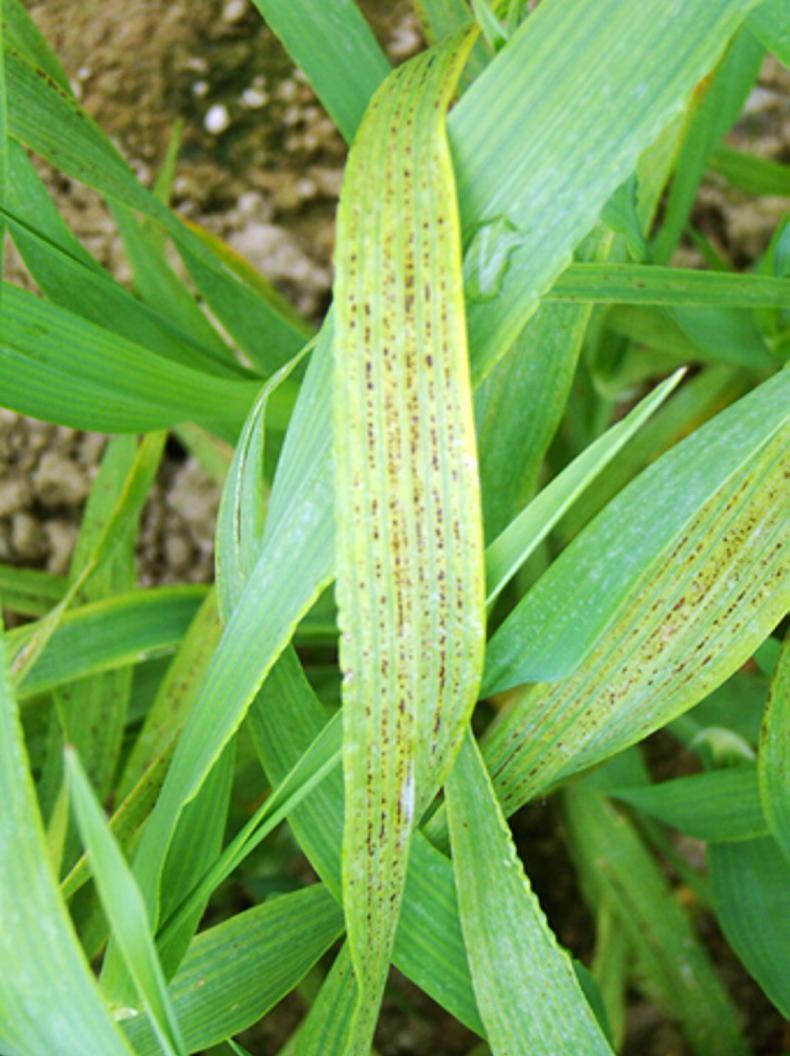
Manganese deficiency symptoms showing the pale leaf that is generally wider and longer than normal and the areas of tissue between the veins beginning to senesce.
Manganese is probably the most common and the most widespread trace element deficiency.
Most soils have adequate soil manganese levels but having it in the soil does not necessarily mean it is available to plants.
The risk of manganese deficiency is influenced by soil pH, soil organic matter and soil texture.
Availability is influenced by pH, with high levels (>7) likely to reduce availability and vice versa. However, practical experience would indicate that manganese is not necessarily deficient where pH is naturally high, but availability can be reduced following lime application to acid soils.
It is also worth noting that manganese availability in soil is likely to be higher in the root zone than in the soil bulk because it is solubilised by the organic acids released by the roots.
Availability of manganese to a crop can also be influenced by dry soil conditions and shallow rooting but such problems can disappear following rain.
Risk of deficiency is always worse on organic and sandy soils, after cold/wet periods and in fluffy seedbeds.
For this latter reason, it is common to see wheel tracks remain green in a patch of deficiency.
Symptoms
Deficiency normally occurs in irregular patches in a field.
Dry periods like we have now are likely to aggravate deficiency, even in fields that would not normally show a problem. Problems will be exaggerated in fields that normally show deficiency.
Manganese plays a major role in photosynthesis and it is also important for the synthesis of chlorophyll and for nitrogen absorption.
Where manganese is deficient, the plant senses the reduced efficiency of photosynthesis and acts to increase leaf surface area by making the leaf grow wider and longer and it also becomes much paler.
Areas of tissue in the affected leaves will begin to die and the foliage can quickly disintegrate.
Prevention and cure
As with any deficiency, yield potential will be lost when symptoms are evident.
For this reason, it is important to preempt a problem and act to keep it away rather than to correct it. This is the principle behind seed dressings and fertiliser coatings like Wolftrax.
Preventing signs of deficiency should help secure higher yield potential.
For this same reason, manganese problems in winter cereals should be treated in autumn to help growth.
Spring treatments will work, but yield potential may have been lost if the deficiency was present in autumn. The same principle applies to spring treatments – strike early before any symptoms can be seen.
There are many products that can be used to treat a deficiency.
Seed dressings, Wolftrax on the fertiliser, sulphate sprays and a range of chelates. These differ in cost but the better formulations will be more effective when a problem needs to be cured.
Good formulation can cure a problem with less element but it is unlikely that any formulation will provide a total solution from a single treatment.
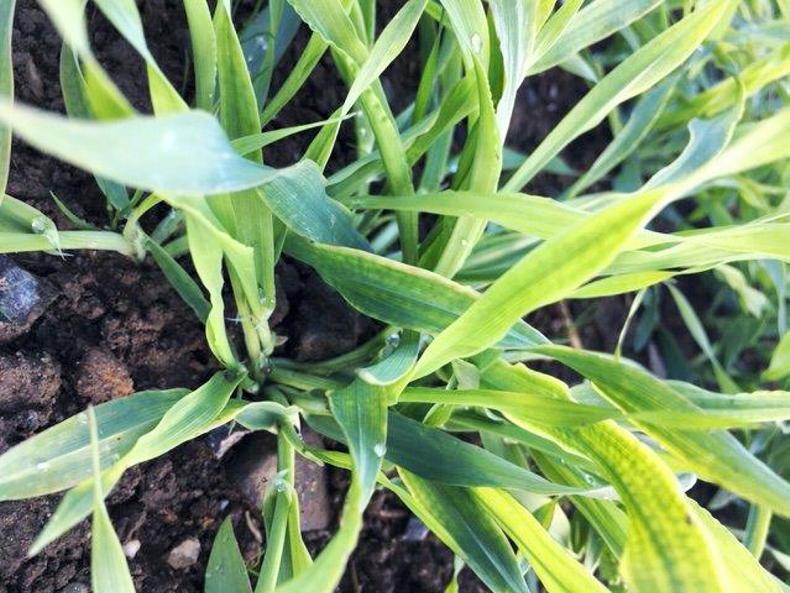
Magnesium deficiency in spring barley showing white edges on some leaves and the mottled or beaded pattern along the leaves.
Magnesium is a component in plant chlorophyll and, as such, plays a role in stimulating photosynthesis.
It is responsible for activating a range of plant enzymes and it is also important in early-stage crop development.
Deficiencies can be caused by a range of factors, some of which are soil-related while others are weather-related.
For example, crops grown in sandy or acidic soils are more prone to deficiencies, as are potassium- or calcium-rich soils.
Ground which receives high levels of potash can also be prone to deficiency. Prolonged wet and cold periods, or crops which have poor root development, could also result in deficiencies.
Symptoms
Mg deficiency can be destructive and generally appears on older leaves first.
Symptoms are initially spotted as a yellowing of the tissue between the leaf veins. Leaves become pale in colour as the problem continues due to lack of chlorophyll (revealed by holding a leaf to the sunlight).
Small bright speckles also spread over the leaf and in worst-case scenarios, leaf margins begin to die, starting from the tip.
Treatment
Application of a foliar Mg is highly effective at providing the nutrient when it is needed and to temporarily alleviate a deficiency. Mg may also be applied as a coating on fertiliser.
Elsewhere, ensure adequate Mg levels in soils by replacing nutrient off-take each year and avoid under- or over-liming. Mg can also be applied using a high-magnesium limestone.
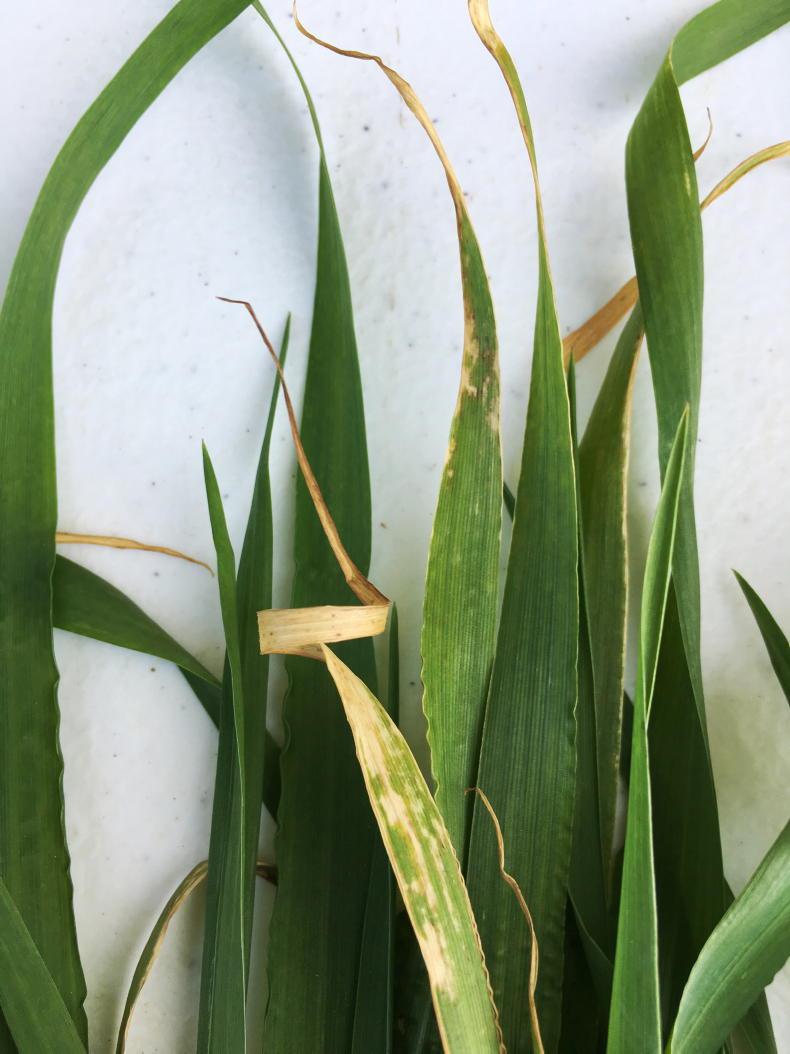
Copper deficiency in spring barley showing the white senesced tip on some leaves with one showing the corkscrew effect.
Copper acts as an key enzyme activator in plants and has an indirect role in chlorophyll production.
It is also very important in a plant’s reproductive stage of growth. In cereals, it is important for ear formation, floral fertility and grain development.
A Cu deficiency can result in lowered levels of chlorophyll, which will lead to yield reductions.
Early visual symptoms can be tricky to spot so a deficiency can be verified by a tissue test.
Soils high in organic matter can decrease the availability of Cu. Sandy and light soils, as well as soils with a high pH, are also prone to deficiency.
Symptoms
Cu is relatively immobile in the plant and tends to remain in the older leaves. This means deficiency symptoms are most common in younger growth.
Deficiency symptoms in the early stages (GS12-GS19) include stunting of plants, pale green plant appearance and the tips of the youngest leaves becoming white.
Leaf spiralling may also occur. After, GS20-GS29 plants appear pale green in colour with white tips.
Affected ears are white and “rat-tailed” in appearance, with blind grains in the ear.
Treatment
Where crops are treated early, they will make a good recovery.
Apply foliar Cu spray at early to late tillering (GS21/29).
Late tillering to early boot stage is the most effective time to apply Cu as part of a split application.

One of the many different possible symptoms of zinc deficiency showing the pale area at the base of the leaves.
Zinc deficiency is not something we hear a lot about in cereal crops, but zinc plays an important role in energy regulation and chlorophyll production in the plant, both of which are important for photosynthesis and yield.
It has a significant effect on grain quality and the number of grains a plant produces.
Zinc deficiency is associated with high-pH soils. It is more common in soils with pH >6.0, so tillage crops grown at the appropriate soil pH range are susceptible.
Soils that are high in phosphorus, or those receiving a large amount of phosphorus, are also at risk of zinc deficiency.
Where tissue samples are being taken on a leaf to help identify a deficiency, zinc is deficient when it is less than 20mg/kg in cereal plant tissue.
A deficiency can also be identified by soil analysis.
Identification/symptoms
However, zinc deficiency is difficult to identify as a plant symptom.
Some describe it as yellow tipping on the top of the plant’s leaves; yellow stripes or white spots on the leaves; while others indicate light brown lesions surrounded by a dark brown edge, which could easily be confused with rhynchosporium if not examined in detail.
Treatment
Early treatment is vital and sometimes splitting the application in two sprays can be beneficial. This might mean applying a half rate at the three- to five-leaf stage and the second half around GS30.
Boron deficiency is most commonly associated with beet and oilseed rape. In beet it leads to crown rot, where the beet has a black heart in its crown.
It is essential for crop development and with improved tuber quality and reduced tuber browning in potatoes.
It is common on soils with pH >7 which are low in organic matter and where lime was recently applied. It can be more common in drought and where high levels of nitrogen or calcium are present.
Identification/symptoms
Leaves look shrivelled and small, turning black. Internodes can be short in oilseed rape, resulting in a rosette-type appearance. Misshapen pods and red leaves can also occur.
Treatment
Over-application of boron should be avoided and potatoes, legumes and cereals are particularly sensitive. Boron can be applied with the fertiliser for beet at a rate of 3kg/ha, but a follow-up foliar spray may be needed.
Boron can also be included with the fertiliser for oilseed rape or applied as a foliar spray as soon as there is enough leaf to take in the nutrient. A follow-up spring application can also be beneficial.
A deficiency of any element, macro or micro, will limit plant growth and yield potential. While manganese is the most common trace element deficiency, other elements can be problematic on specific soil types.Trace elements are most commonly associated with chlorophyll, photosynthesis and enzyme activation.
Trace element deficiencies are an annual occurrence on some land and a more widespread issue in times of excessive dryness.
All elemental deficiencies can be treated with the deficient element(s) and the amount required will depend on the formulation used.
Sulphates are the cheapest treatments but they may not always work adequately as they can subsequently get tied up in the soil by the same issues that caused the deficiency in the first place.
There are many other formulations of chelated trace elements on the market in recent years.
More sophisticated formulations work better and faster
The chelate protects the element for improved uptake by the crop and it is the uptake capability that governs the amount of the element that must be applied to cure a problem.
More sophisticated formulations work better and faster and they can be more expensive while applying less of the element.
It is also worth noting that these elements are called trace elements because they are required in very small quantities. Applying them in large quantities can cause other imbalances and indeed some of them can be toxic.

Manganese deficiency symptoms showing the pale leaf that is generally wider and longer than normal and the areas of tissue between the veins beginning to senesce.
Manganese is probably the most common and the most widespread trace element deficiency.
Most soils have adequate soil manganese levels but having it in the soil does not necessarily mean it is available to plants.
The risk of manganese deficiency is influenced by soil pH, soil organic matter and soil texture.
Availability is influenced by pH, with high levels (>7) likely to reduce availability and vice versa. However, practical experience would indicate that manganese is not necessarily deficient where pH is naturally high, but availability can be reduced following lime application to acid soils.
It is also worth noting that manganese availability in soil is likely to be higher in the root zone than in the soil bulk because it is solubilised by the organic acids released by the roots.
Availability of manganese to a crop can also be influenced by dry soil conditions and shallow rooting but such problems can disappear following rain.
Risk of deficiency is always worse on organic and sandy soils, after cold/wet periods and in fluffy seedbeds.
For this latter reason, it is common to see wheel tracks remain green in a patch of deficiency.
Symptoms
Deficiency normally occurs in irregular patches in a field.
Dry periods like we have now are likely to aggravate deficiency, even in fields that would not normally show a problem. Problems will be exaggerated in fields that normally show deficiency.
Manganese plays a major role in photosynthesis and it is also important for the synthesis of chlorophyll and for nitrogen absorption.
Where manganese is deficient, the plant senses the reduced efficiency of photosynthesis and acts to increase leaf surface area by making the leaf grow wider and longer and it also becomes much paler.
Areas of tissue in the affected leaves will begin to die and the foliage can quickly disintegrate.
Prevention and cure
As with any deficiency, yield potential will be lost when symptoms are evident.
For this reason, it is important to preempt a problem and act to keep it away rather than to correct it. This is the principle behind seed dressings and fertiliser coatings like Wolftrax.
Preventing signs of deficiency should help secure higher yield potential.
For this same reason, manganese problems in winter cereals should be treated in autumn to help growth.
Spring treatments will work, but yield potential may have been lost if the deficiency was present in autumn. The same principle applies to spring treatments – strike early before any symptoms can be seen.
There are many products that can be used to treat a deficiency.
Seed dressings, Wolftrax on the fertiliser, sulphate sprays and a range of chelates. These differ in cost but the better formulations will be more effective when a problem needs to be cured.
Good formulation can cure a problem with less element but it is unlikely that any formulation will provide a total solution from a single treatment.

Magnesium deficiency in spring barley showing white edges on some leaves and the mottled or beaded pattern along the leaves.
Magnesium is a component in plant chlorophyll and, as such, plays a role in stimulating photosynthesis.
It is responsible for activating a range of plant enzymes and it is also important in early-stage crop development.
Deficiencies can be caused by a range of factors, some of which are soil-related while others are weather-related.
For example, crops grown in sandy or acidic soils are more prone to deficiencies, as are potassium- or calcium-rich soils.
Ground which receives high levels of potash can also be prone to deficiency. Prolonged wet and cold periods, or crops which have poor root development, could also result in deficiencies.
Symptoms
Mg deficiency can be destructive and generally appears on older leaves first.
Symptoms are initially spotted as a yellowing of the tissue between the leaf veins. Leaves become pale in colour as the problem continues due to lack of chlorophyll (revealed by holding a leaf to the sunlight).
Small bright speckles also spread over the leaf and in worst-case scenarios, leaf margins begin to die, starting from the tip.
Treatment
Application of a foliar Mg is highly effective at providing the nutrient when it is needed and to temporarily alleviate a deficiency. Mg may also be applied as a coating on fertiliser.
Elsewhere, ensure adequate Mg levels in soils by replacing nutrient off-take each year and avoid under- or over-liming. Mg can also be applied using a high-magnesium limestone.

Copper deficiency in spring barley showing the white senesced tip on some leaves with one showing the corkscrew effect.
Copper acts as an key enzyme activator in plants and has an indirect role in chlorophyll production.
It is also very important in a plant’s reproductive stage of growth. In cereals, it is important for ear formation, floral fertility and grain development.
A Cu deficiency can result in lowered levels of chlorophyll, which will lead to yield reductions.
Early visual symptoms can be tricky to spot so a deficiency can be verified by a tissue test.
Soils high in organic matter can decrease the availability of Cu. Sandy and light soils, as well as soils with a high pH, are also prone to deficiency.
Symptoms
Cu is relatively immobile in the plant and tends to remain in the older leaves. This means deficiency symptoms are most common in younger growth.
Deficiency symptoms in the early stages (GS12-GS19) include stunting of plants, pale green plant appearance and the tips of the youngest leaves becoming white.
Leaf spiralling may also occur. After, GS20-GS29 plants appear pale green in colour with white tips.
Affected ears are white and “rat-tailed” in appearance, with blind grains in the ear.
Treatment
Where crops are treated early, they will make a good recovery.
Apply foliar Cu spray at early to late tillering (GS21/29).
Late tillering to early boot stage is the most effective time to apply Cu as part of a split application.

One of the many different possible symptoms of zinc deficiency showing the pale area at the base of the leaves.
Zinc deficiency is not something we hear a lot about in cereal crops, but zinc plays an important role in energy regulation and chlorophyll production in the plant, both of which are important for photosynthesis and yield.
It has a significant effect on grain quality and the number of grains a plant produces.
Zinc deficiency is associated with high-pH soils. It is more common in soils with pH >6.0, so tillage crops grown at the appropriate soil pH range are susceptible.
Soils that are high in phosphorus, or those receiving a large amount of phosphorus, are also at risk of zinc deficiency.
Where tissue samples are being taken on a leaf to help identify a deficiency, zinc is deficient when it is less than 20mg/kg in cereal plant tissue.
A deficiency can also be identified by soil analysis.
Identification/symptoms
However, zinc deficiency is difficult to identify as a plant symptom.
Some describe it as yellow tipping on the top of the plant’s leaves; yellow stripes or white spots on the leaves; while others indicate light brown lesions surrounded by a dark brown edge, which could easily be confused with rhynchosporium if not examined in detail.
Treatment
Early treatment is vital and sometimes splitting the application in two sprays can be beneficial. This might mean applying a half rate at the three- to five-leaf stage and the second half around GS30.
Boron deficiency is most commonly associated with beet and oilseed rape. In beet it leads to crown rot, where the beet has a black heart in its crown.
It is essential for crop development and with improved tuber quality and reduced tuber browning in potatoes.
It is common on soils with pH >7 which are low in organic matter and where lime was recently applied. It can be more common in drought and where high levels of nitrogen or calcium are present.
Identification/symptoms
Leaves look shrivelled and small, turning black. Internodes can be short in oilseed rape, resulting in a rosette-type appearance. Misshapen pods and red leaves can also occur.
Treatment
Over-application of boron should be avoided and potatoes, legumes and cereals are particularly sensitive. Boron can be applied with the fertiliser for beet at a rate of 3kg/ha, but a follow-up foliar spray may be needed.
Boron can also be included with the fertiliser for oilseed rape or applied as a foliar spray as soon as there is enough leaf to take in the nutrient. A follow-up spring application can also be beneficial.
A deficiency of any element, macro or micro, will limit plant growth and yield potential. While manganese is the most common trace element deficiency, other elements can be problematic on specific soil types.Trace elements are most commonly associated with chlorophyll, photosynthesis and enzyme activation. 







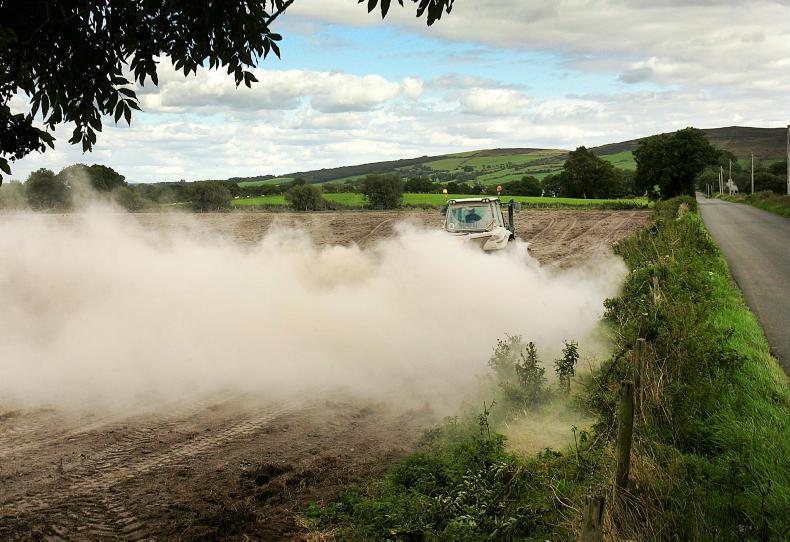
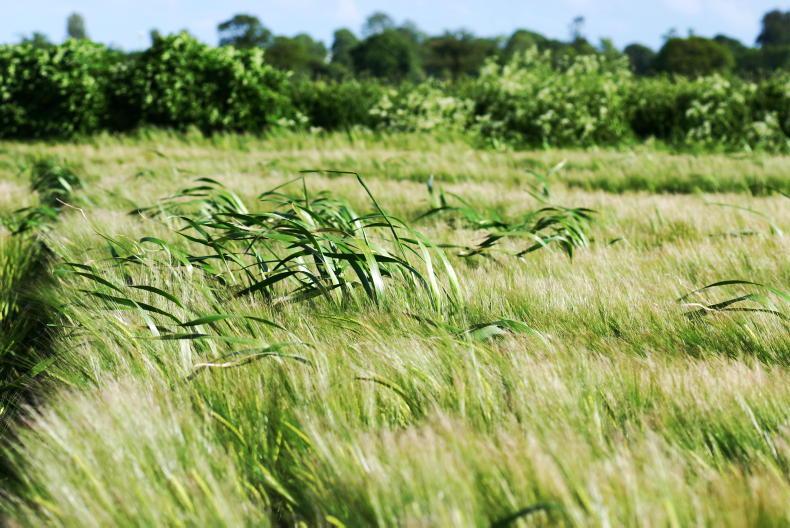



SHARING OPTIONS